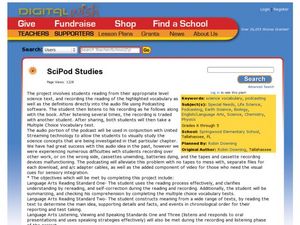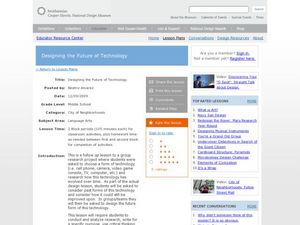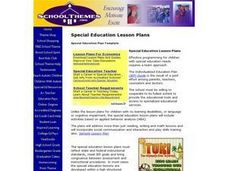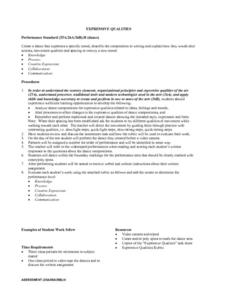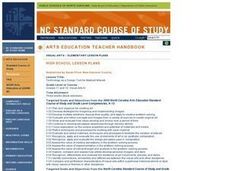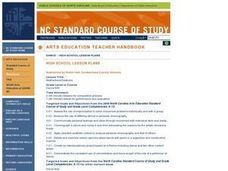Curated OER
Sands of Time
Young scientists take a close looks a samples of sand that come from three different beaches. They use microscopes to view the three slides, and make observations on a worksheet. At the end of the lesson, learners share their...
Curated OER
As a Matter of Fact
Elementary-aged scientists discover that all matter has mass. They are shown the difference between mass and weight, and learn how to calculate mass using the appropriate tools and methods. The scientific method is used while estimating...
Curated OER
SciPod Studies
Have fun preparing a science podcast. After reviewing vocabulary, learners record audio files to create science vocabulary podcasts for particular units of study. A clever way to incorporate technology.
Curated OER
Designing the Future of Technology
Conduct research focused on improving a current technology by having students work in groups to investigate improvements that could be made to a particular piece of technology. They list the current problems and attempt to develop...
Huntington Library
Light in Painting
How do painters use and manipulate light in their artwork to give emphasis and establish mood and emotion? Pupils will analyze a few examples of landscape and portrait painting in order to explore the how light is used in art,...
Berkshire Museum
Nature Journaling: Experience the Outdoors Through Writing and Drawing
Step into the great outdoors and develop young scientists' skills of observation with a nature journaling lesson. Given a specific focus or goal, children practice making and recording observations of nature through written descriptions...
Curated OER
Alcohol and Pregnancy Don't Mix!
Seventh graders learn about John Kellerman, a youngster who was born with Fetal Alcohol Syndrome. They learn how alcohol and pregnancy doesn't mix.
Curated OER
Special Education Plan
Special needs students practice completing everyday tasks such as organizing a day plan, reading a clock and completing simple math problems. They define the proper learning techniques for their disorder and utilize props in...
Curated OER
Protective Design
Over 3 or 4 class periods your young designers will create a wearable garment that provides some sort of protection from a danger in everyday life. In this fashion design lesson, students investigate fear in our society and brainstorm...
Curated OER
A Garden of Verses: Poems About Class Gardens
Students explore botany by participating in a language arts activity. In this garden poetry lesson, students read the classic poem "Mary, Mary Quite Contrary" and discuss the imagery and rhyming methods used. Students examine their own...
Curated OER
Blogging to Create a Community of Writers
One of the keys for successful teaching is connecting curriculum to real-life experiences. This instructional activity on blogging does this, by making writing, revising, and publishing a reality. Pupils create a character for a story,...
National Center for Case Study Teaching in Science
Bad Fish, Bad Bird
In an advanced biology lesson, learners see a PowerPoint about biologist Dr. Westwood, a two-time victim of poisoning. Designed to be used with clickers in the classroom, you could modify the lesson by creating a worksheet from the...
Pleasant Valley Community School District
Integumentary System
This document can be used as a slide show to introduce your human body systems class to the integumentary system, also know as skin. Topics outlined include the roles of skin, details about its its layers, and color (cause and...
Curated OER
EXPRESSIVE QUALITIES
Students create a dance that expresses a specific mood. They describe the composition in writing and explain how they would alter actions, movement qualities and spacing to convey a new mood. They perform the dance they created...
Curated OER
Studying An Artist
Students examine the artwork of a specific artist and attempt to create a painting in the style of the studied artist in this middle and high school level Art lesson. Rubric is included for self- and teacher assessment after the project...
Curated OER
Technology as a Design Tool for self-portraits
Students create self-portraits using the technology of digital cameras mixed with other media. Adobe Photoshop is a requirement for this specific three week project. State standards for the arts are addressed.
Curated OER
Technology as a Design Tool for Abstract Artwork
Young scholars manipulate pictures using Adobe Photoshop and digital cameras to produce unique abstract works. This lesson can be modified to include a painting/mixed media element. State standards are addressed in this lesson.
Curated OER
Abstractions/Gestures
Students examine and display the differences between literal, and non-literal movement and abstraction using a creative project in movement. This project originates as an individual item, culminating in a small group performance.
Curated OER
Major Organic Acids in Fruits
Students investigate the organic acids present in a variety of juices. In this organic acids lesson plan, students read about the effects of organic acids in juices. They use paper chromatography to separate out the acids present in a...
Curated OER
Cardboard Structure: Pyramids
Young scholars design a structure made of cardboard pyramids that will hold their weight. In this pyramid structure activity, students determine a way to make a structure of interlocking pyramids that are sturdy enough to hold a...
Curated OER
Embryology Word Search Puzzle
In this biology word search worksheet, students search for 36 terms related to embryology. They check off the words as they find them in the puzzle.
Curated OER
Integrated Dance Curriculum: Snow
Students, through the leading questions, guided imagery, and dance, gain a greater comprehension of snow, weather, and the five senses.
Curated OER
See Spot Run
Students identify several properties of water as a universal substance, describe the composition of several complex color mixtures and separate the components of dye using chromatographic technique.
Curated OER
Primary Color Mixing
Third graders identify secondary colors that are created by mixing primary color paint combinations, and make paintings of their own.


